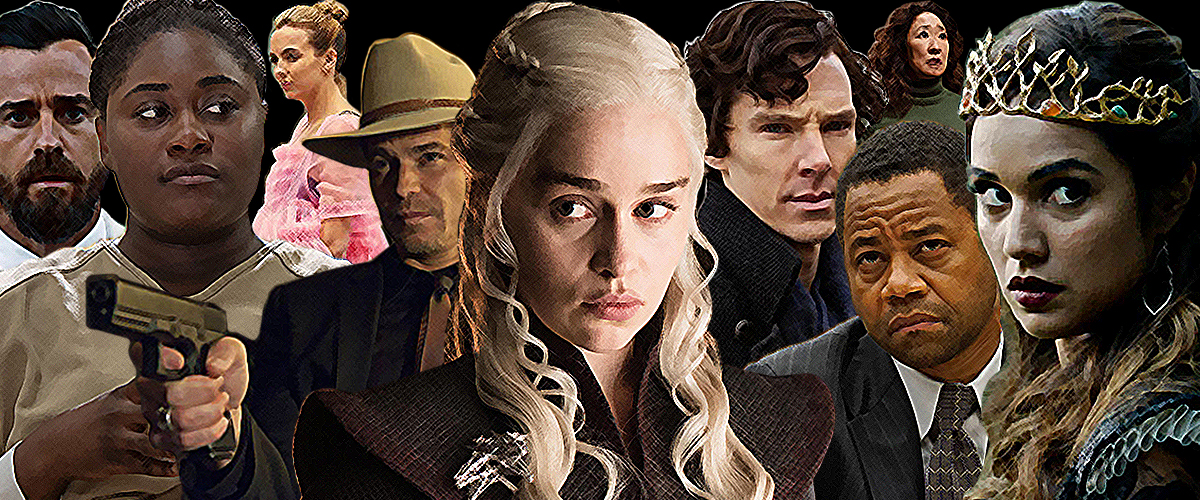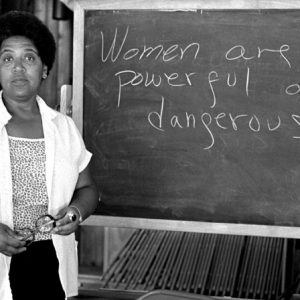As you may have noticed, over the past few weeks, we’re been looking back at the best books from the decade, from novels to poetry to nonfiction. As a sort of coda to that project, I’ve also polled the Literary Hub staff about their favorite literary adaptations of the decade, on both the big and small screens. Our list of favorite film adaptations will be along later this week, but for now, here are the decade’s very best television shows that started out from books.
Take note that we attempted to judge the shows in question on their own independent merits; while many of us have read the books these shows are based on, we didn’t base our decisions on fidelity to, or creativity of departure from, the original text. We just wanted to pick the best television experiences.
As with the previous lists, the following top ten small screen adaptations were chosen after a lengthy debate among the Literary Hub staff. It got testy, but in the end, we agreed—though many of us had to include our dissenting opinions at the end of the list. If we’ve missed your favorite, tell us why we’re wrong in the comments.
***
The Top Ten
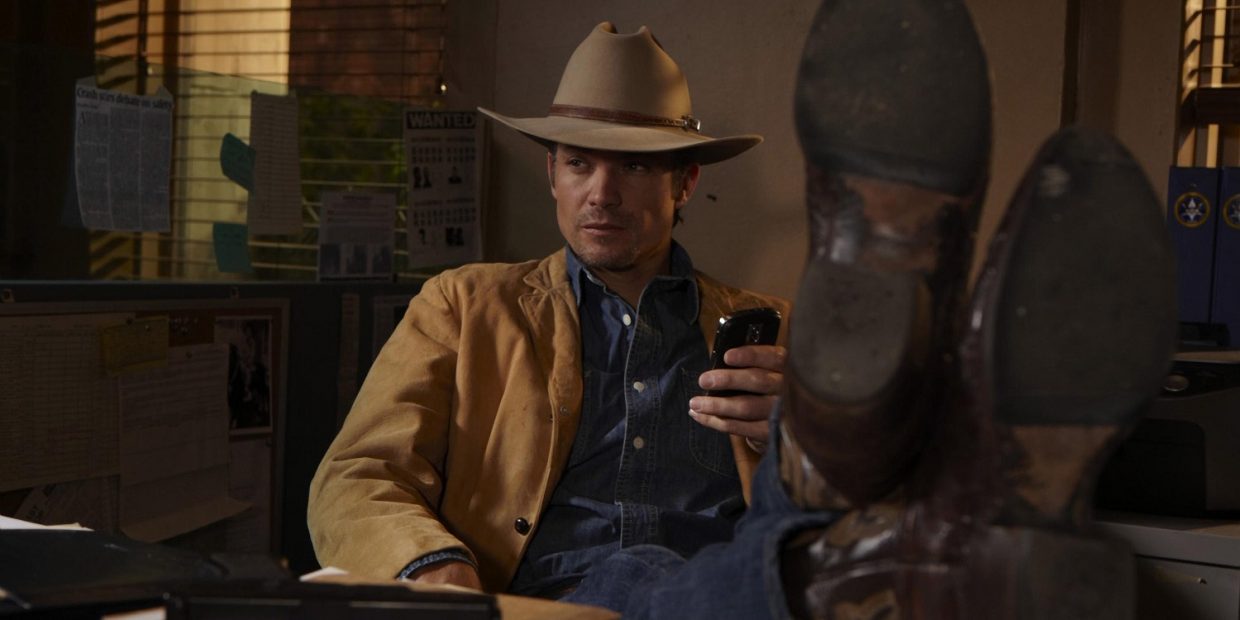
Justified (FX, 2010-2015)
Based on: “Fire in the Hole” by Elmore Leonard
Calling Justified, the FX series that premiered in March of 2010 and ran for six glorious seasons, a literary adaptation is at once misleading and fundamentally, somewhat poetically accurate. As a starting point, it’s nominally based on the Elmore Leonard short story, “Fire in the Hole,” which introduces US Marshal Raylan Givens, a plays-by-his-own-rules fugitive hunter who returns to his hometown of Harlan, Kentucky and has some tension with an old coal mining buddy turned criminal, Boyd Crowder. All of that gets the show through a few episodes. But what really, and a little counterintuitively, makes Justified such an achievement of literary adaptation is that even once the series was off-book, as it were, it always felt distinctly located within the strange and wonderful moral universe of Elmore Leonard’s fiction.
Every character had a hustle going, every crime required several minutes of banter, and the line between hero and lowlife was ever thin. The Crowders, the Crowes, the Bennetts, the Givens—all these hill clans, criminal or otherwise, carried down their own traditions and moral codes, and sure enough they more often than not came into conflict. Creator and showrunner Graham Yost has famously said that the writers of the series would wear bracelets bearing the initials WWED as a reminder, whenever they were stuck on a plot development or a character arc, to ask themselves, “What Would Elmore Do?” The great author’s stamp is all over this show, a modern western-cum-crime show that smuggles in a few Shakespearean touches and adds some pretty steamy sexual tension to boot. Through the magic of great source material and great week-to-week writing, not to mention the phenomenal acting, Justified established itself as one of the decade’s most entertaining series, and without a doubt one of its most stylish.
–Dwyer Murphy, CrimeReads Managing Editor
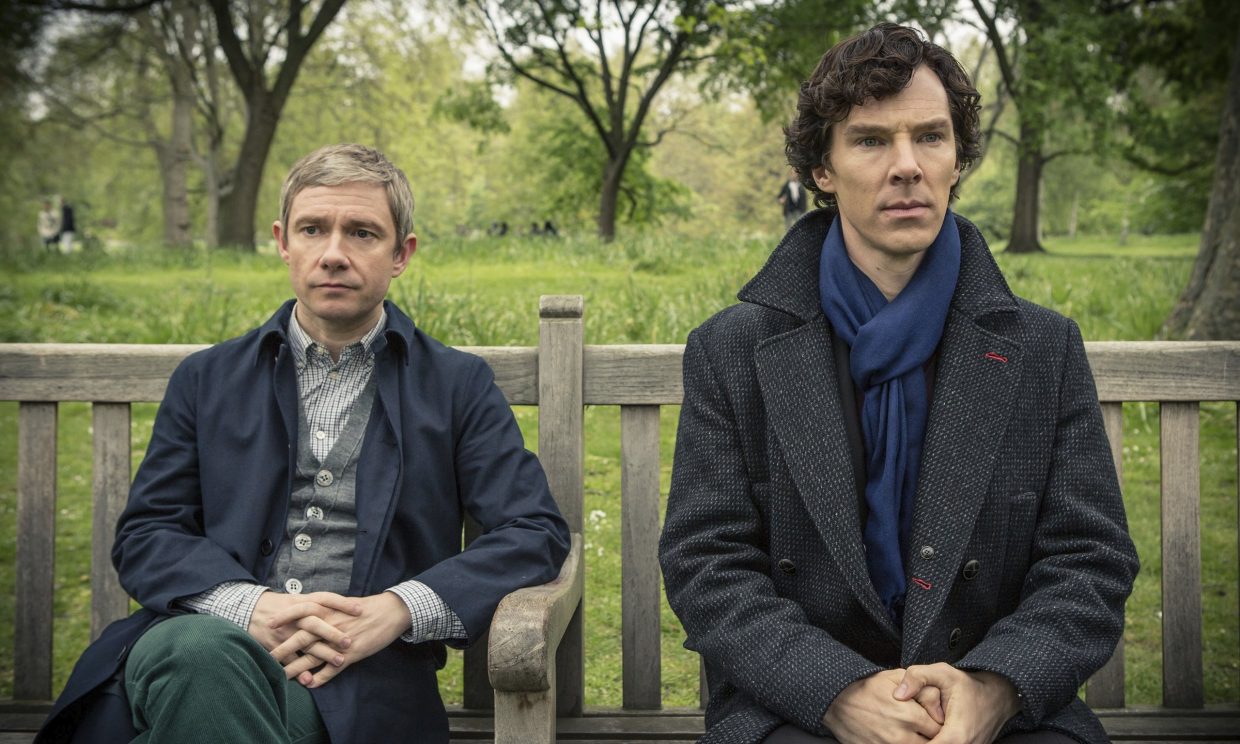
Sherlock (BBC, 2010-2017)
Based on: The Sherlock Holmes stories, by Arthur Conan Doyle (1887-1927)
Sir Arthur Conan Doyle’s The Adventures of Sherlock Homes has taken on a life of its own. The characters have starred in other writers’ stories, and the premise has been adapted for television and film many, many times. The best adaptation, I daresay, features Benedict Cumberbatch as a brilliant, impatient, delightfully smug Sherlock to Martin Freeman’s compassionate Watson, an earnest war veteran who blogs about their crime-solving adventures. And who could forget Andrew Scott’s role as Moriarity? Before he was the Fleabag’s Hot Priest, he was a twisted mastermind pulling the strings in a theatre of cruelty. The crimes are eerie and psychologically haunting (years later, you’ll find yourself thinking of the woman in “A Study In Pink,” who tried to claw her daughter’s name in the floorboards before she died, as a clue) but there’s a playfulness there, too. Benedict Cumberbatch’s Sherlock and Andrew Scott’s Moriarity mirror each other in a clever cat-and-mouse dance, and it’s fun to watch. You buy into their love of the game. You learn to love it, too. (The fun makes it all the more creepy, really. You wonder if Sherlock, if all of us, aren’t a little more like Moriarity than we care to admit.) And, of course, the unlikely friendship between Sherlock and Martin Freeman’s Watson is another great joy of the series. The wonderful thing about this adaptation is that as it goes on, it becomes less about individual one-off mysteries and more about the characters’ backstories and growth, their individual psychology—the greatest mystery of all.
–Katie Yee, Book Marks Assistant Editor
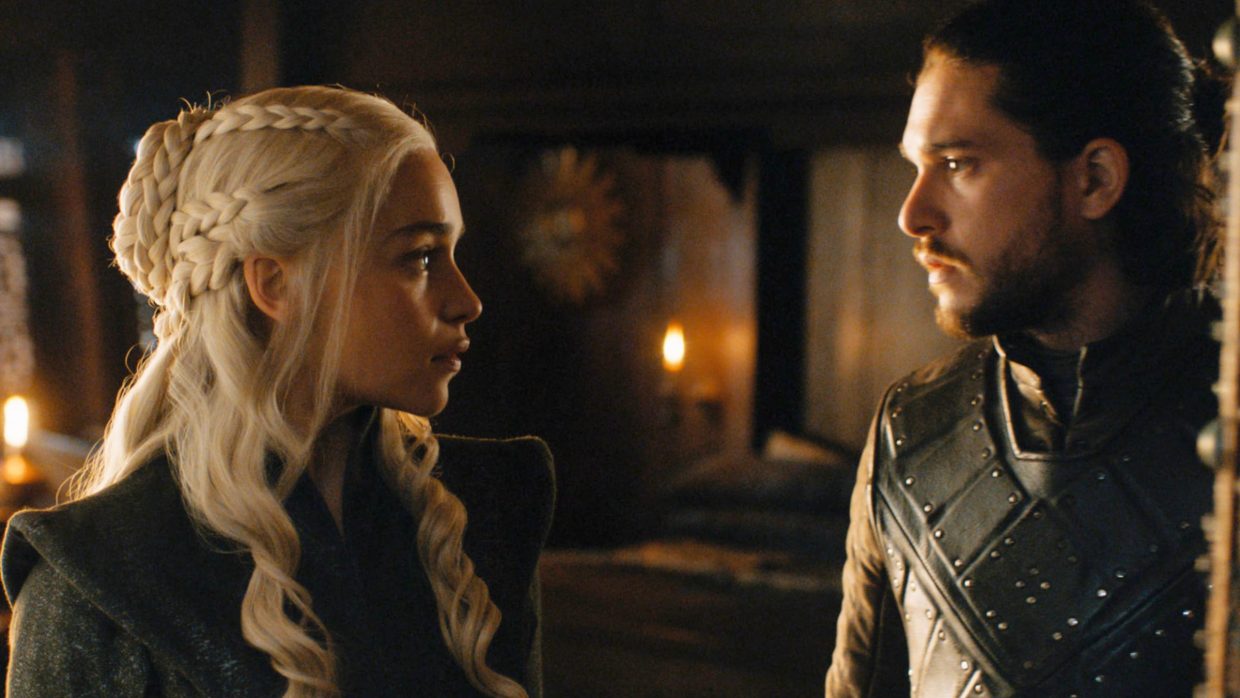
Game of Thrones (HBO, 2011-2019)
Based on: A Song of Ice and Fire by George R. R. Martin
Quibble with the final season, go ahead, I won’t stop you. Quibble with the bouts of misogyny and overly graphic/exploitative background action, which may or may not have been appropriate to the time and place depicted, a fantasy realm so who the hell knows? But what you can’t quibble with, or even overstate, really, is the cultural impact of Game of Thrones, one of the most fervently and widely watched series in the history of modern television and a global pop culture phenomenon like no other on this list. It didn’t matter if you were a fantasy nerd, a reader, an avid watcher of television, or a virtual recluse; chances are at some point during the decade past, Game of Thrones came across your radar, you decided to watch it, and probably got into some very involved discussions of its progress.
There were kings, queens, courtiers, schemers, risers, fallers, dragons, clashing civilizations, more dragons, and more worlds to discover every week. And it was ambitious to boot. With David Benioff and D.B. Weiss at the helm, adapting the epic works of George R.R. Martin’s Song of Ice and Fire cycle, the priority was placed on closely observed worlds and the type of passionate, high-stakes storytelling that have marked sagas and origin stories from the dawn of time. Look, if you’ve read this far and have never tried or enjoyed Game of Thrones, I don’t know what to tell you. Probably you can’t be converted. Or maybe now that the dust has settled you’ll give it another shake. Maybe not. All I’m sure of is that for several years this decade, there was a show that a good portion of the human race was really, really into. It was the show everybody seemed to be watching, and when they went off-book, for better or worse, and drew the whole thing to a close, it was invigorating to know that a community around the world was fully immersed in the same rich story.
–Dwyer Murphy, CrimeReads Managing Editor
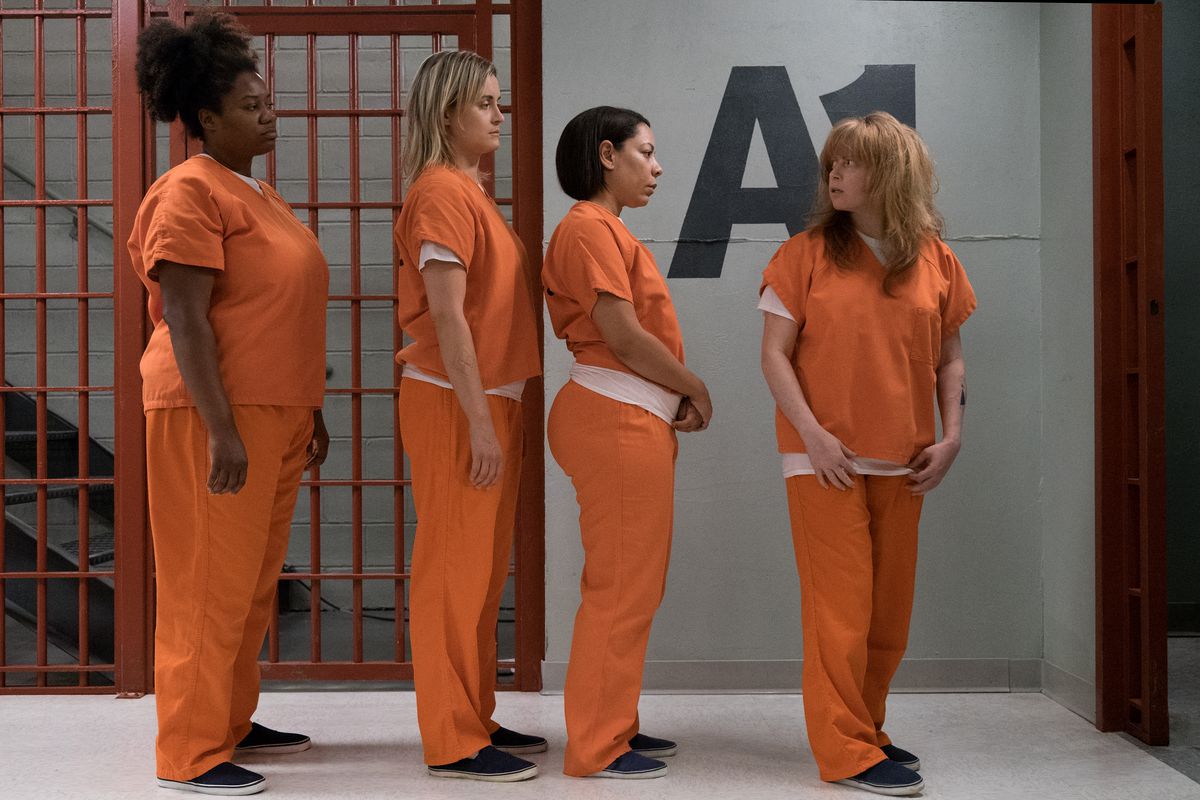
Orange is the New Black (Netflix, 2013-present)
Based on: Orange is the New Black by Piper Kerman (2010)
Admittedly, Orange is the New Black had its ups and downs (everyone has their own ranking, and while I’m not sure there’s any true consensus, I feel confident in saying Season 2 forever), but on the whole, it’s impossible not to highlight it here. We were introduced to the inmates of Litchfield Penitentiary in 2013, only a few years after the release of Kerman’s much-hyped memoir about her time as a Nice White Lady in prison, but the show has far eclipsed the book. Part of it was luck: it was one of Netflix’s earliest forays into original programming. As TV critic Judy Berman wrote:
Brought to bear on [creator Jenji Kohan’s] expansive vision at a critical moment in the rise of streaming, that freedom yielded a series that smoothed the transition from cable’s 2000s golden age to the vibrant and diverse, if fragmented, era that’s come to be known as Peak TV. More than a bold experiment in representational sleight of hand, Orange became the most influential show of the decade.
. . .
[I]t would be hard to underestimate how much has changed on the small screen since 2013. . . . the phrase “binge watching” was just starting to gain currency when the first season of Orange—all 13 hours of it—showed up on Netflix. Viewers who now regularly consume a full season’s worth of a given series within 24 hours still weren’t sure that they could get used to this new form of couch potato–dom. Kohan’s show played no small part in converting skeptics. I remember marathoning the season in a weekend, spurred on by my impatience to know everyone in Orange’s tremendous cast of characters. For better or worse, bingeing is now so common that a term for watching one episode of TV at a time would be more useful.
Which isn’t even to scratch the surface of what has really been so influential and satisfying about this show: its massive cast, and that cast’s ability to portray a diverse, complicated group of women—something never seen before on television, or at least not at this magnitude. Judy again:
When it came to representation, this wasn’t merely the first prestige show since The Wire built around poor and nonwhite people—or the rare program intended for a general audience that featured more than a token queer regular. It also endowed each of these characters with stereotype-defying specificity. In 2014, when this magazine declared that America had reached a “transgender tipping point,” Laverne Cox’s breakthrough role as trans inmate Sophia Burset made her the face of that moment. For once, women whom mainstream society habitually ignored were being represented in pop culture as individuals with virtues and flaws, rather than as a monolithic mass of degenerates or vixens.
And of course, it was a hell of a lot of fun, too. It had good stories, unforgettable characters, and witty repartee in spades—and those are probably why it’s actually been so massively popular: Netflix says that 105 million people (actually, users, which as we all know might mean multiple people) have watched at least one episode, which makes it the platform’s most-watched original offering. Which certainly says something. We’ll just forget about season six. And five.
–Emily Temple, Senior Editor
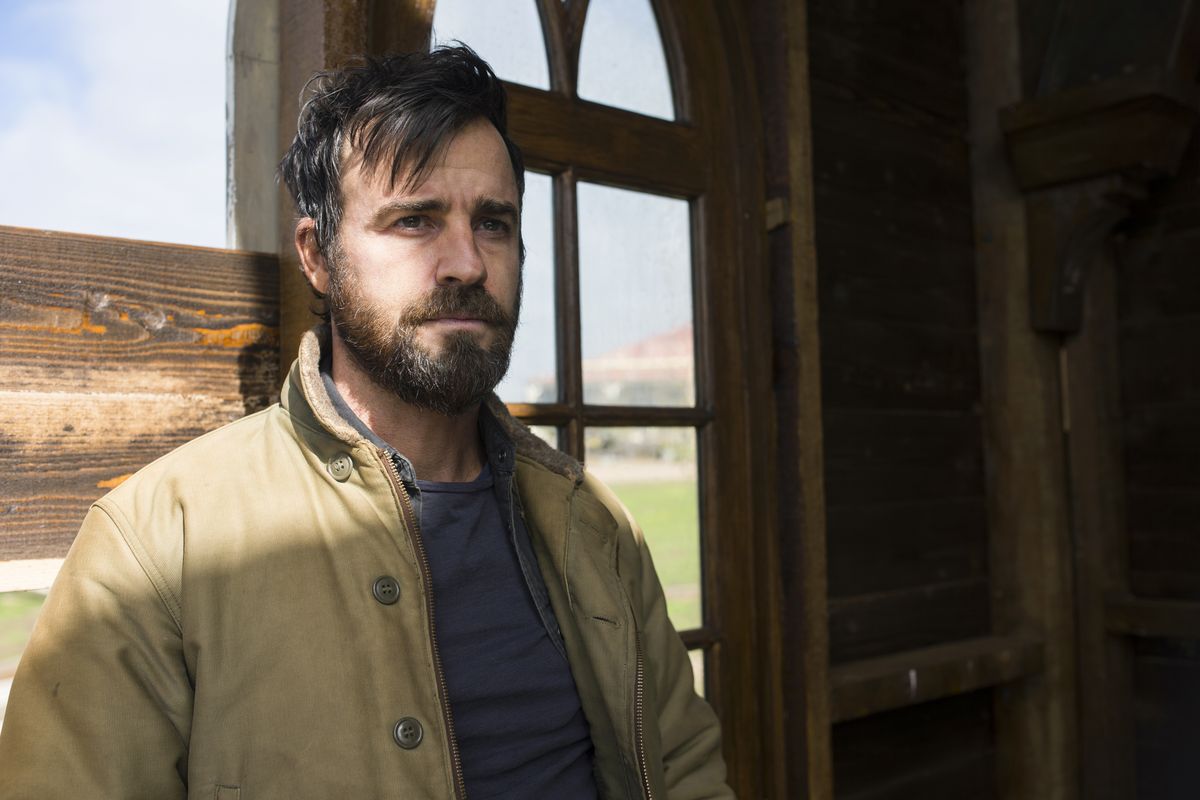
The Leftovers (HBO, 2014-2017)
Based on: The Leftovers by Tom Perrotta (2011)
Damon Lindelof and Tom Perotta’s supernatural mystery drama series (centered around brooding upstate New York police chief Kevin Garvey and his family as they struggle to adjust to life in the wake of the Departure—a mysterious global event that resulted in 2% of the world’s population disappearing from the face of the earth) was that rarest of birds: a literary adaptation that successfully expanded upon, and eventually transcended, its source material to become something altogether more glorious and profound. The first season (which many found too relentlessly grim but which I have a real soft spot for), a relatively straightforward adaptation of Perotta’s novel, focused on Garvey’s attempts to keep the peace between the still-raw citizenry of his small town and the inscrutable nihilist cult (the Guilty Remnant) which has ensnared his wife. The Second (which marked a complete tonal reimagining of the show) took place in Jarden, Texas—the site of the Garveys’ fresh start, chosen for its famed status as the only town in America which suffered no Departures—and the Third brought our battered antiheroes and their hefty emotional baggage to Australia as the auspicious seventh anniversary of the Departure approached.
There are so many scorching, aching performances in this show—from Christopher Eccleston’s increasingly desperate reverend to Ann Dowd’s uncompromising Guilty Remnant matriarch, Liv Tyler’s terrifying convert-turned-zealot to Scott Glenn’s grizzled and (possibly) insane Kevin Garvey Sr.—but none more memorable than Carrie Coon’s career-making turn as Nora Garvey, a woman stripped bare, reconstituted, by the enormity of her Departure Day trauma. Like Watchmen, Lindelof’s equally brilliant new creation, The Leftovers was a wildly ambitious vision—epic in scope, devastating in emotional impact, and admirably unafraid of drifting into silliness, surrealism, and near-incomprehensibility when it wanted to. It was a show about the weight of grief, about trying to live in a world made strange and terrible by incomprehensible loss, with all the rage and despair and absurdity that would characterize the experience of such a world.
–Dan Sheehan, Book Marks Editor
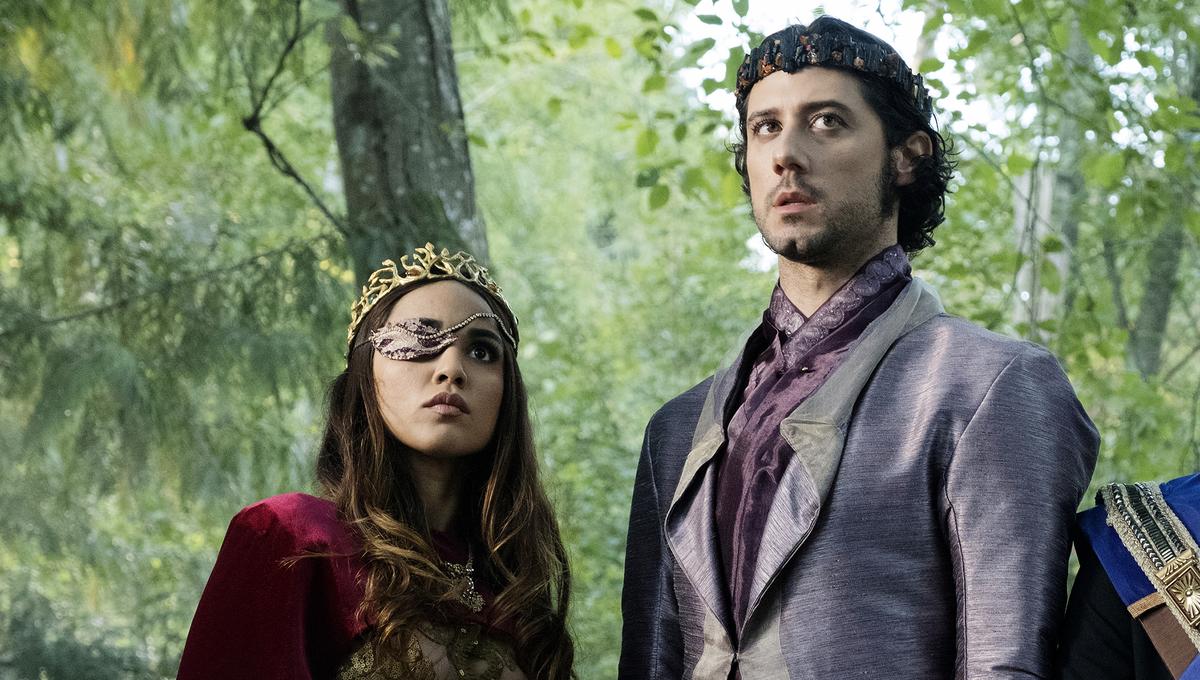
The Magicians (Syfy, 2015-present)
Based on: The Magicians trilogy by Lev Grossman (2009-2014)
The Magicians is a show for nerds. I’m not saying that if you’re not a nerd, you won’t enjoy it—I think there’s a little something for everyone—but The Magicians trades on references, on lampshading tropes and reinventing legends, and as such it rewards prior knowledge. For those of us who have been consuming fantasy and science fiction for our whole lives, it is deeply funny and satisfying—after all, at its core, it’s about a group of people just like us, who watched Buffy and read The Lord of the Rings, and then one day woke up to find that the were invited to magical grad school.
And sure, the first season is only okay. But after that, it becomes pretty stunning. It’s fucking fun, and smart, and populated by fresh characters—which sets it securely apart from most fantasy, to be fair. Season three contains one of the best episodes of television I’ve ever seen: Eliot and Quentin get stuck out of time on a quest, and it takes decades, and they live their entire lives together, and they die. Of course there’s a way out, their characters continue, but it shakes you to your core—because it suddenly shows you how much you’ve come to care about the characters on a silly, magical, backtalking show.
–Emily Temple, Senior Editor
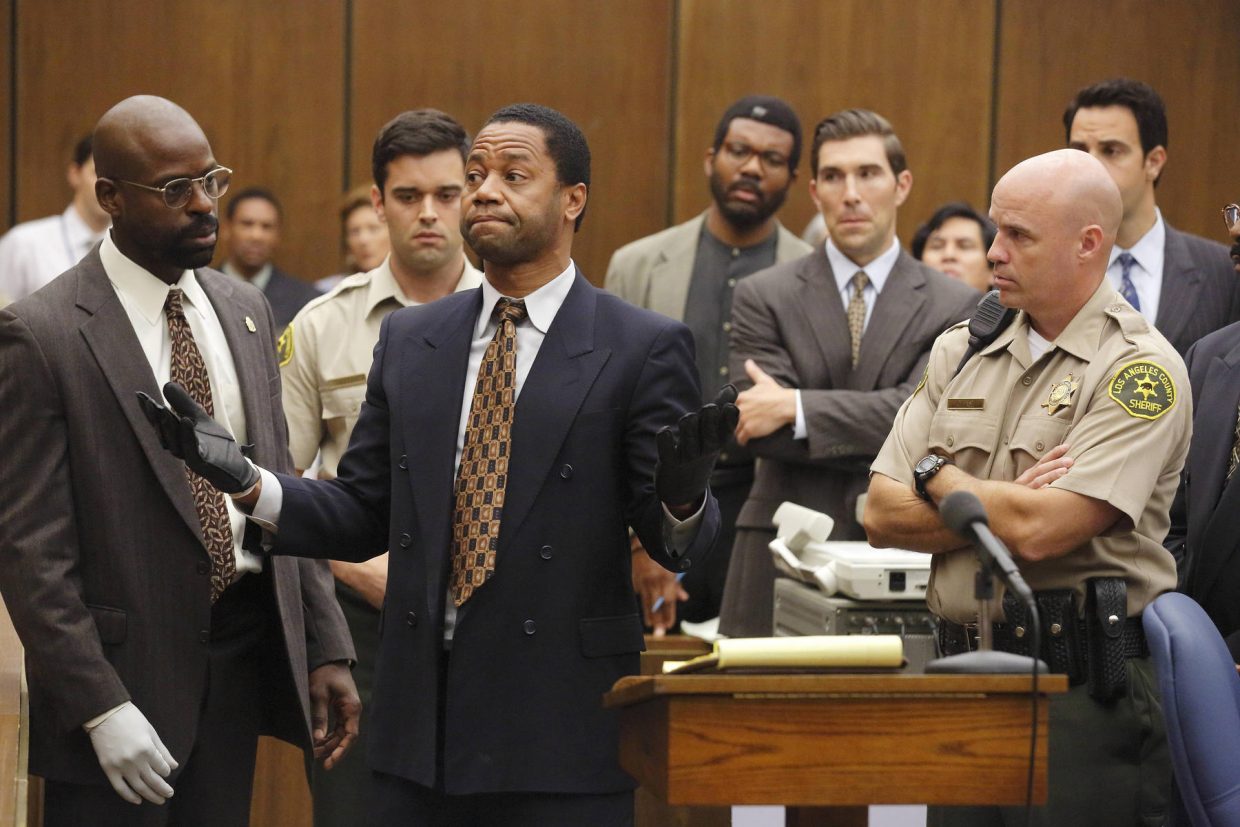
The People v. O.J. Simpson: American Crime Story (FX, 2016)
Based on: The Run of His Life: The People v. O. J. Simpson by Jeffrey Toobin (1997)
For at least the past century, the United States has had a central role in enabling global celebrity cults thanks, in large part, to the Hollywood-industrial complex and the widespread diffusion of visual media. The appeal of memes and GIFs, as we now know them, have something to do with the spectacle of a re-playable moment, or a strange, indelible image circulated in like-minded groups. Ultimately The People v. O.J. Simpson, the first season of the American Crime Story anthology series, is a screenshot of one of the most pivotal cultural moments in late 20th-century U.S. history. This dramatization of the O.J. Simpson trial, steered along by an excellent cast led by Sterling Brown, Sarah Paulson, Courtney Vance, and Cuba Gooding Jr., took the audience back through a scandal seen around the world that revealed how wealth, fame, and race captivated the American public on the very eve of the Internet boom. What you didn’t talk about at the dinner table if you wanted to keep your most private feelings to yourself was money, religion, and whether you were for or against O.J.
–Aaron Robertson, Assistant Editor
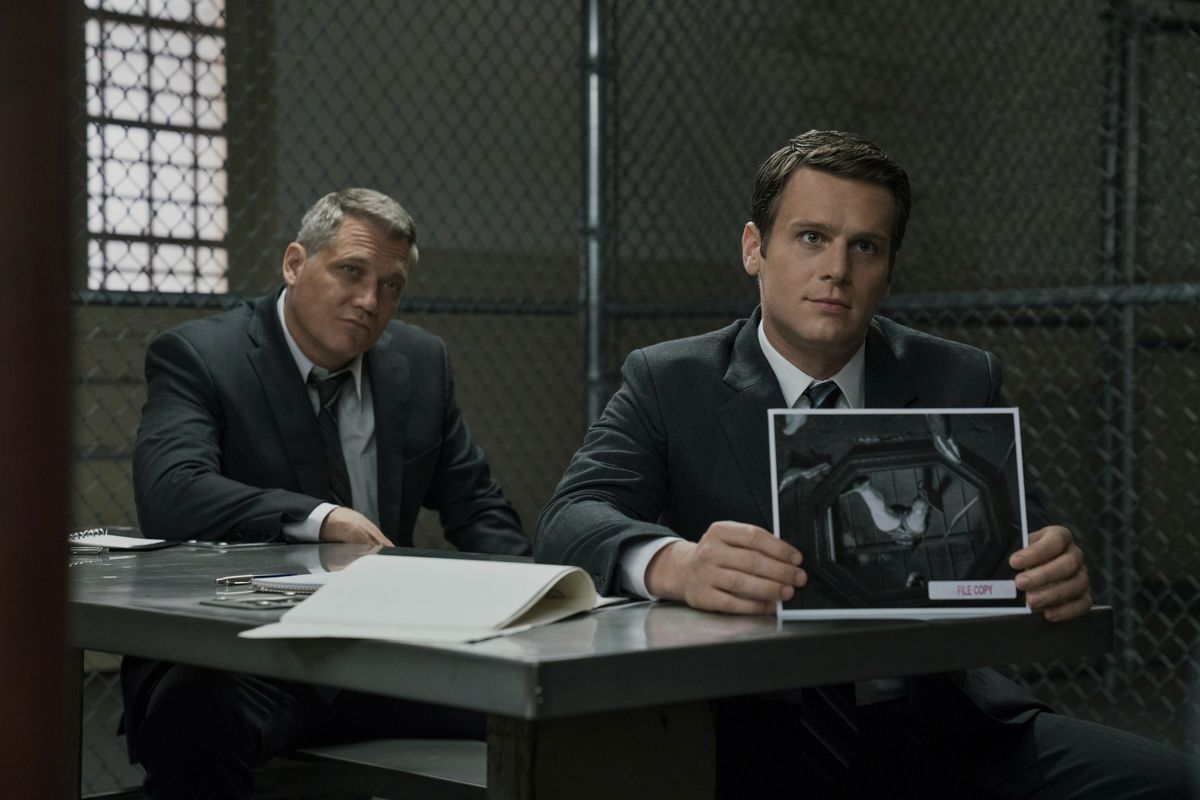
Mindhunter (Netflix, 2017-present)
Based on: Mindhunter: Inside the FBI’s Elite Serial Crime Unit by John E. Douglas and Mark Olshaker (1995)
Though not quite true crime, the most fascinating characters and storylines of Mindhunter are based on real-life nightmares. Loosely inspired by Joe Penhall’s 1995 book Mindhunter: Inside the FBI’s Elite Serial Crime Unit, the series is set in the late 1970s and early 80s, when the FBI first began systematizing the nature of “multiple murderers,” more commonly known as serial killers. Agent Holden Ford (Jonathan Groff), a brilliant and aloof hotshot in the bureau, teams up with the straight-shooting veteran agent Bill Tench (Holt McCallany) and psychologist Wendy Carr (Anna Torv) to do prison interviews with some of the most notorious mass murderers in US history to understand and apprehend active killers. This includes the likes of Ed Kemper, David Berkowitz (the “Son of Sam”), Charles Manson, and many more. The show leans into noir and, obviously, is not for those with a weak stomach or fluttering heart. Anchored by charismatic performances from the main cast and the excellent guest actors who play the criminals, Mindhunter makes you second-guess how much you can really know about the motivations and psychology of your neighbor, your relatives and, of course, yourself.
–Aaron Robertson, Assistant Editor
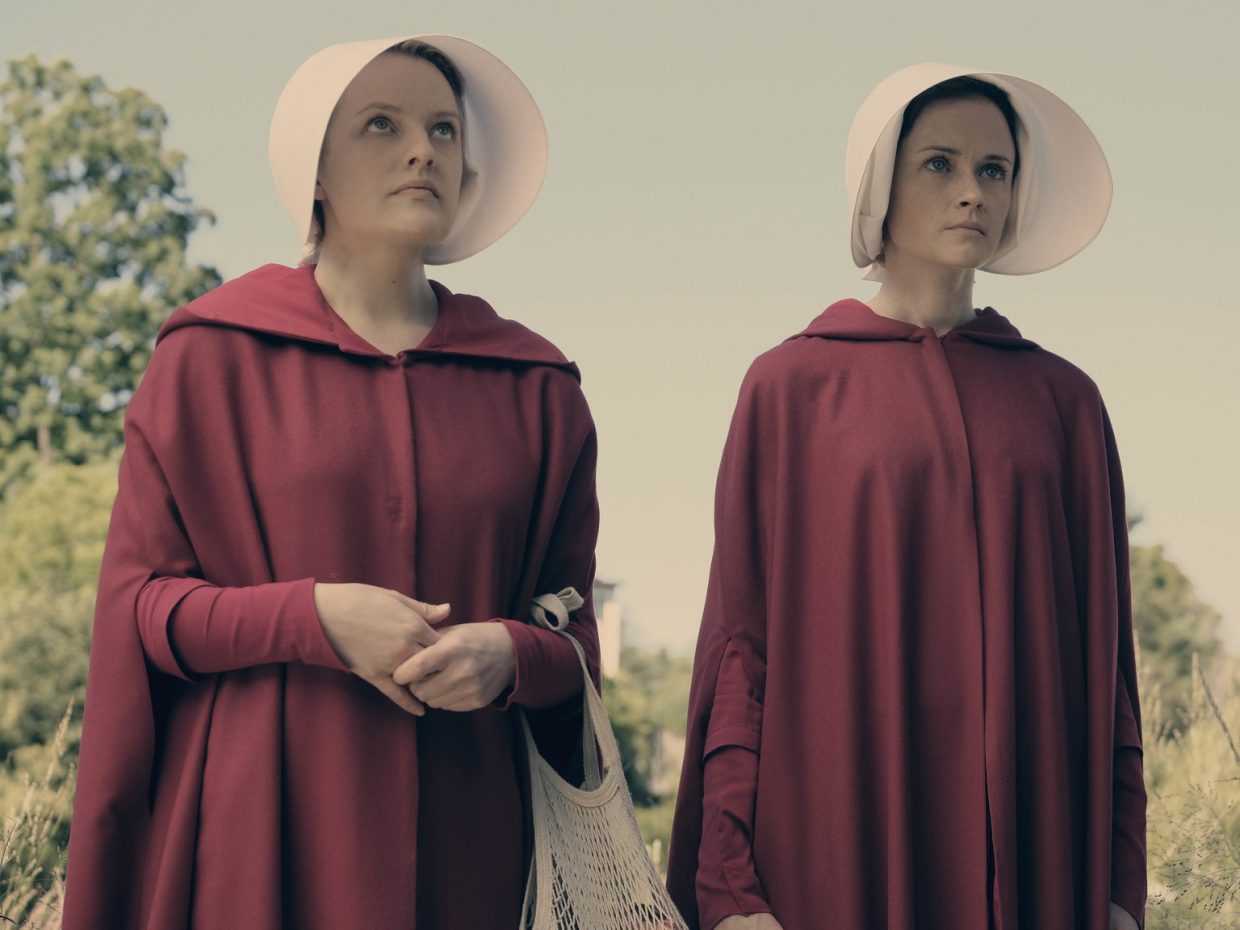
The Handmaid’s Tale (Hulu, 2017-present)
Based on: The Handmaid’s Tale by Margaret Atwood (1985)
Disclaimer: The Handmaid’s Tale is on this list for the first season only. After that, it becomes misery porn.
Despite the way its reputation has been corrupted by overextension and over-merchandising, the first season of The Handmaid’s Tale is incredible. The show is deeply affecting, especially coming at the time it did, when we were all feeling the first, dizzying moments of the normalization of Donald Trump’s behavior. Yes, we were tender, and this show drove the knife in. The adaptation is visually excellent, and extremely successful as horror. The third episode, in which a flashback shows the world just as the world tipped, made me cry, which is an uncommon event. At the time, I wrote:
The horror of the flashbacks is carefully balanced. This does not seem like a society at the edge of a dystopia. It seems exactly like the world we know. But it isn’t. Unless, of course, it is. Would we know? Moira and June laugh at the rude barista because they don’t realize where they live. They are standing on the edge; they can’t see how much things have changed. They are too close, and so are we. This is why the flashbacks are so much more frightening than the present action of the show, despite the bleakness and creep of the latter. A reflection of the violence of your own reality is always much scarier than any dystopian society with special outfits, no matter how many parallels you can draw, no matter how many people are tortured, murdered, or raped. I’m not saying these parts aren’t horrifying—just that they don’t cut to the bone in quite the same way.
That was the brilliance of Atwood’s novel, and that is the brilliance of the show—at least if we ignore everything after 2017.
–Emily Temple, Senior Editor
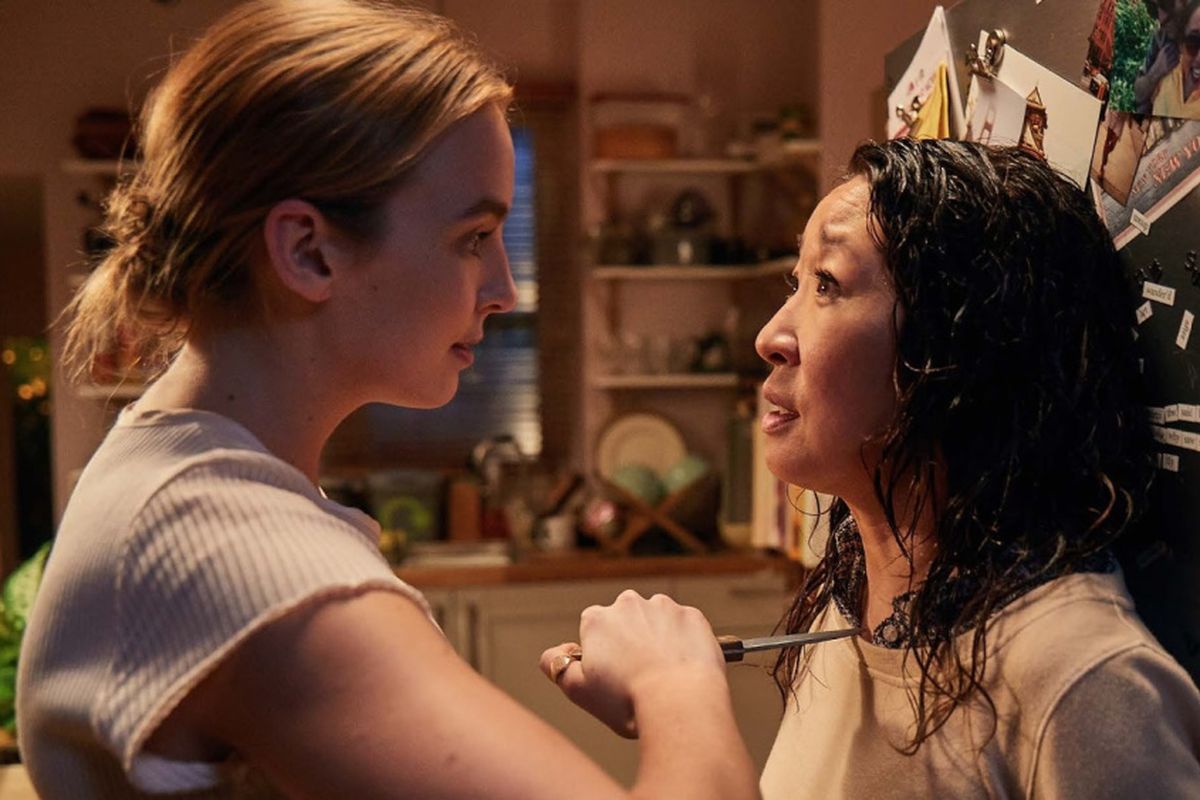
Killing Eve (BBC, 2018-present)
Based on: The Codename Villanelle series by Luke Jennings (2014-2016)
It seems like at this point we should probably have some kind of universal abbreviation to acknowledge how much we all love everything Phoebe Waller-Bridge does so that when the time comes to write about her, we can just pop it in there and not have to spend time trying to figure out a new way to talk about how great she is. For the purposes of this write-up, let’s just agree that everyone in the world would run our loved ones over with a truck just so Phoebe Waller-Bridge would… run us over with a truck. Killing Eve, Waller-Bridge’s adaptation of Luke Jennings’ Codename Villanelle and her follow-up to the first season of Fleabag, is a tremendously fun series that also manages to be taut with suspense. Jodie Comer is fantastic as the beautiful, charming, flirty asshole/contract killer whose mutual obsession with Sandra Oh’s British intelligence officer Eve powers the show, and Fiona Shaw is typically excellent as Eve’s boss/mentor/foil. The script is as sharp and fast and smart as anyone familiar with Waller-Bridge’s work would expect (seriously, run us over with a truck).
–Jessie Gaynor, Social Media Editor
***
Dissenting Opinions
The following adaptations were just barely nudged out of the top twenty, but we (or at least one of us) couldn’t let them pass without comment.

Miss Fisher’s Murder Mysteries (ABC, 2012-2015)
Based on: the Phryne Fisher book series by Kerry Greenwood (1989-2013)
Miss Fisher’s Murder Mysteries, based on the Phryne Fisher book series by Kerry Greenwood, is one of the most enjoyable television series I’ve ever encountered. It’s endlessly delightful. Is it maybe a little too anachronistically on-the-nose with some of its feminist theses? Who cares. Are the CGI locomotives a little too stylized? Why does it matter? Is it maybe a little cheesy how perfectly everything falls into place all the time? Shut up.
Miss Fisher (Essie Davis) is an ahead-of-her-time single lady living in 20s Melbourne. She’s super wealthy and a total flapper, so the show is about how she just does whatever she wants, including (but not limited to) driving fast in fancy motorcars, flirting with a host of handsome dudes, and solving murder mysteries. Much to the chagrin of her old-fashioned Aunt (Australian national treasure Miriam Margoyles), and often accompanied by her BFF Mac (Tammy MacIntosh), a lady doctor who wears men’s clothes, the indefatigable Miss Fisher operates as a private investigator, consternating the Melbourne Police Chief, Detective Jack Robinson (Nathan Page) and, really, the patriarchy at large. Obviously, his annoyance grows into admiration, but they have one of the most enjoyable slow-burn love stories on modern television. Miss Fisher’s is an ensemble program that places questions about labor and compensation front and center—she employs everybody she enlists, which means that her gorgeous Victorian terraced house is full of (paid) talented misfits, including Mr. Butler (Richard Bligh), her mild-mannered but former-special-ops butler; Burt and Cec (Travis McMahon and Anthony J. Sharpe), two charming lower-class communist factotums who do ground-level espionage (and car maintenance); and Dot (Ashleigh Cummings), her shy gal-Friday who grows more empowered with every passing episode. A cute but also very meaningful aspect of the show is that Dot is being courted by Hugh (Hugo Johnstone-Burt), a handsome but bumbling police officer who means well but has fuddy-duddy ideas about women, and we get to watch him slowly internalize how to be a true ally as Dot learns she deserves an ally.
So. The jazzy aesthetic is fabulous and the chemistry between the actors is superb. It is the perfect show for when you just want to watch a sartorially-superior, vaguely-historically-revisionist period piece detective show in which women kick ass and men respectfully defer to their expertise. The show’s principles really mean a lot; it’s a thrill to live in its world, even for forty-three minutes at a time. No matter what else in this world is not, Miss Fisher’s Murder Mysteries is there for you.
–Olivia Rutigliano, CrimeReads Editorial Fellow
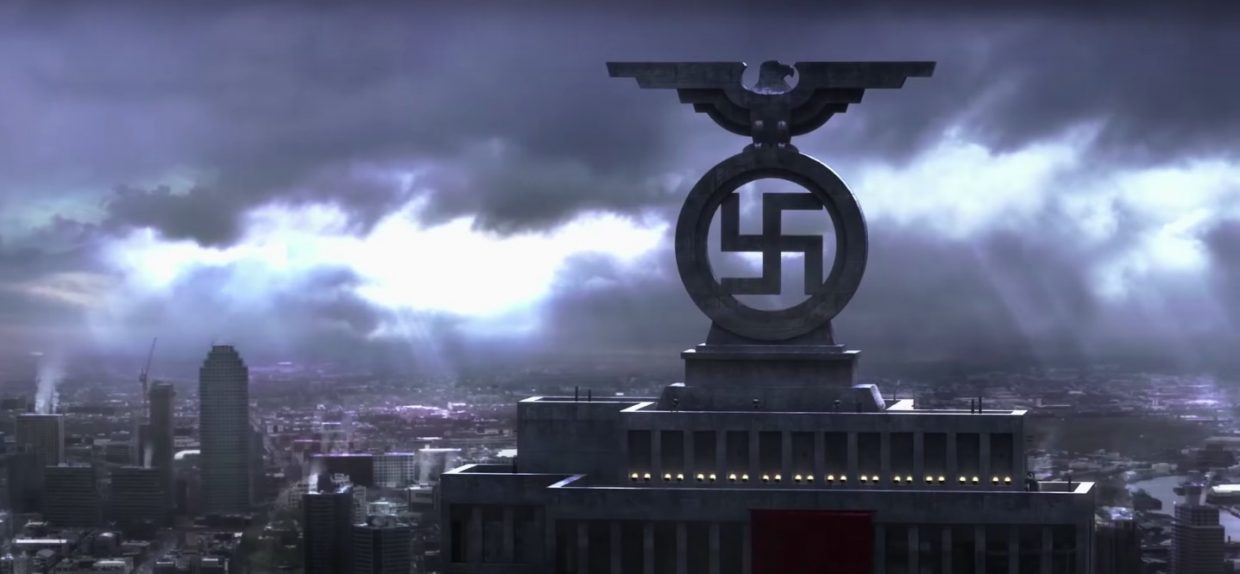
The Man in the High Castle (Amazon, 2015-2019)
Based on: The Man in the High Castle by Philip K. Dick (1962)
Based on Philip K. Dick’s 1962 novel about an alternate history in which the Axis Powers won World War II, The Man in the High Castle is one of Amazon Studio’s best original series. In the show’s universe—one of them, at least—Nazi Germany rules the eastern seaboard while the Japanese empire has control of the West. These powers are separated by a “Neutral Zone” in the middle of the country, a lawless region that is also the only nominally safe area for ethnic and religious minorities. The first season’s phenomenal world-building set the stage for a long, dark tale of resistance and complicity within a social order that, unfortunately, is not so far removed from our own reality. Though the writing sometimes veered unintentionally into melodrama, the show was largely exceptional in mixing elements of espionage thrillers, speculative horror, and the multiverse romp. The final season is the most explicit in questioning the extent to which social surroundings shape our characters. We’d like to think the distance between an American patriot and a fascist loyalist is substantial. What if the most frightening thing about our worst selves is that we are able to imagine it at all?
–Aaron Robertson, Assistant Editor
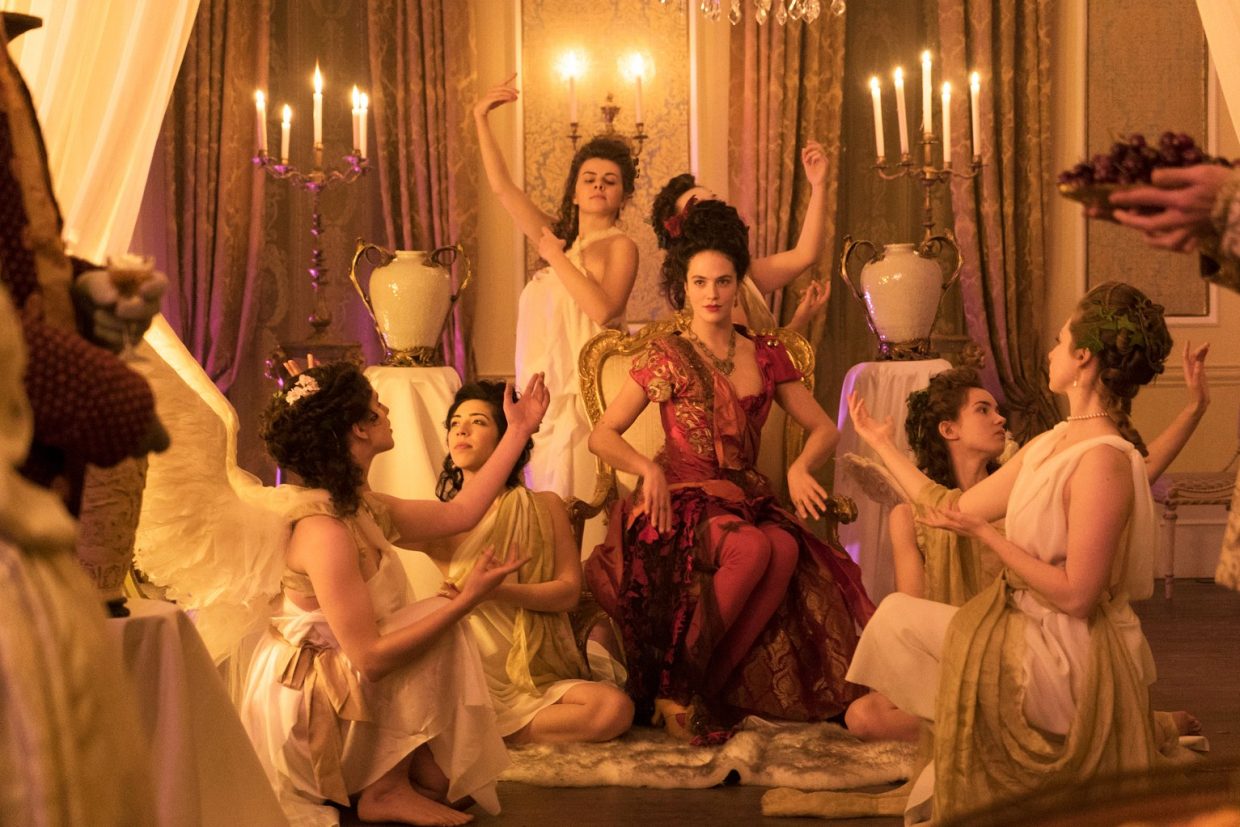
Harlots (Hulu, 2017-present)
Based on: The Covent Garden Ladies by Hallie Rubenhold (2005)
Harlots is the best show on TV you’re not watching—and possibly the best show on TV, period. Adapted from The Covent Garden Ladies: Pimp General Jack and the Extraordinary Story of Harris’ List, by Hallie Rubenhold, Harlots takes place in Georgian England, at a time when one in five women in London worked in the sex industry, and when many of the better paid escorts would receive reviews in a little black book that made its way to all the most discerning johns of the era, providing modern historians with rich details of a bygone era.
Harlots primarily explores the rivalry between two opposing bordellos; one is dedicated to providing basic shelter and protection for sex workers (for a small fee), while the other is classier, but more exploitative of its residents. Like The Deuce, Harlots provides a model for how to make a feminist show about sex workers. Harlots is not only based on a book by a woman, it’s also directed by a woman, stars primarily women, is written almost entirely by women, and generally passes the Bechdel Test in almost every scene. There was even (briefly) a blog created by sex workers to review each episode of Harlots.
It’s also incredibly well-written and oodles of fun, with more drama in each episode than in an entire season of Big Little Lies. Each season wraps up neatly but leaves plenty of room for the next, and as the show progresses, we’re introduced to the wider world of Georgian England, filled with bare-knuckle boxing, dissolute aristocrats, molly houses, and entrepreneurs of all stripes.
The lavish set design and deep historical research compliments the feminism of the series. Most sex scenes are filmed with sex workers fully clothed, given that it was far too cold and took too long anyway to take all those layers off. Heaving bosoms proliferate, as was the style of the era, but bright colors and warm lighting help distinguish the happier house of prostitution from the more miserable French-influenced house of procurement, where the women are clothed in pastels representing both the aspirations of their house and the rigidity of their madame. For every hooker with a heart of gold, there’s a complicated new take on an old archetype. Queer characters, and characters of color, make their own choices and live their own lives; gender and sexual identity are fluid, and kink alternates between sophisticated and played for laughs.
Hallie Rubenhold has dedicated her career to examining women’s choices (and women’s lots) within the context of their era—a valuable and eminently feminist project. She just won the Bailley Gifford Prize for her most recent work, The Five, which makes the case that Jack the Ripper’s victims were not employed as sex workers, but were, in fact, complicated 19th century women with complicated 19th century lives (primarily, the Ripper’s victims were unhoused women suffering from alcoholism).
–Molly Odintz, CrimeReads Associate Editor
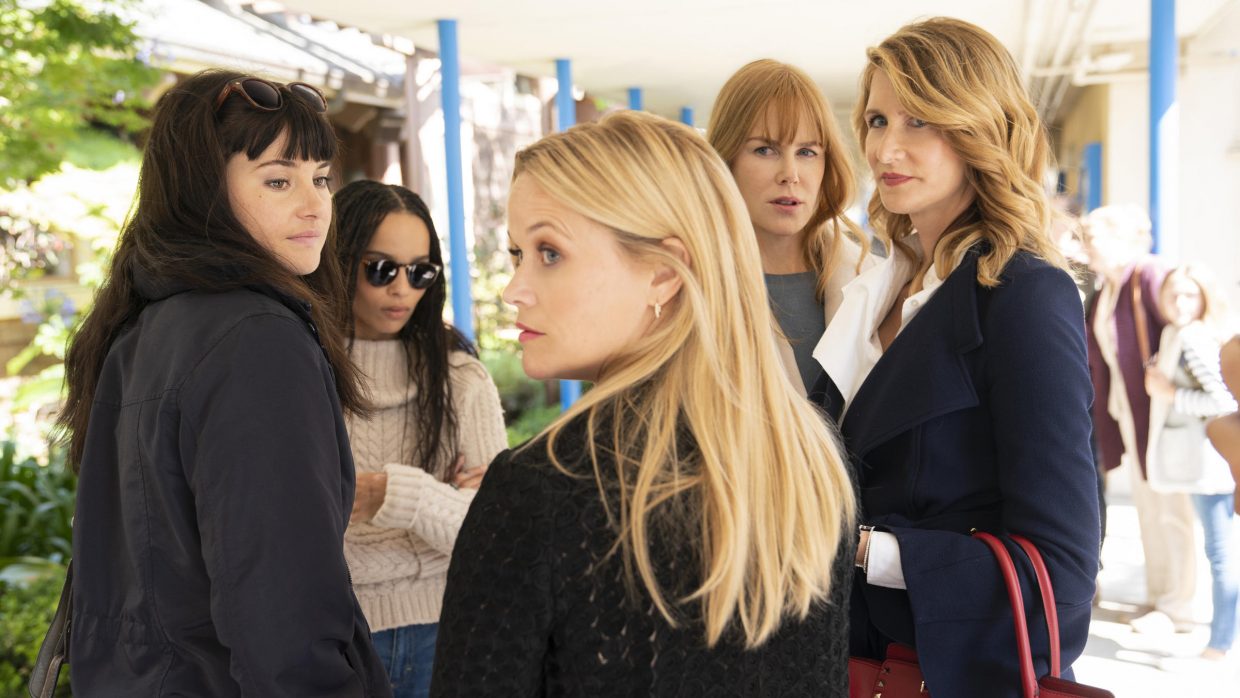
Big Little Lies (HBO, 2017-present)
Based on: Big Little Lies by Liane Moriarty (2014)
Big Little Lies is, on the whole, a good argument for letting Nicole Kidman and Reese Witherspoon do whatever they want; the show is a visually stunning meditation on the inner lives of its five leads, featuring the kinds of complex character studies we rarely see devoted to women. Based on Liane Moriarty’s novel, the show’s first season, directed by Jean-Marc Vallée, builds to a climactic reveal of the titular lie, and along the way it shows each of the five leads at the height of their acting abilities—particularly Nicole Kidman, whose portrayal of surviving physical abuse is unlike anything I’ve ever seen. The characters’ relationship to the surrounding landscape—the stark cliffs of Big Sur and the thin bridges that connect them, the ocean—underlie the show’s sense of tension and precarity, which we see expressed in the constantly shifting social alliances of white, wealthy, privileged Monterey.
However, the series is not without its flaws, and in particular, the show’s treatment of race has been disappointingly vague. The presence of Bonnie’s mother in the second season felt like a missed opportunity to introduce some nuance to that conversation; Reshmi Hebbar noted in Slate that her storyline “catered to racist stereotypes about violent black mothers,” exacerbating the show’s existing issues with race. And in the show’s second season, a battle for creative control between the show’s director and producers gave the show a visually muddled style. Regardless, it’s a pleasure to watch, and its strengths are enough to merit its place on this list.
–Corinne Segal, Senior Editor
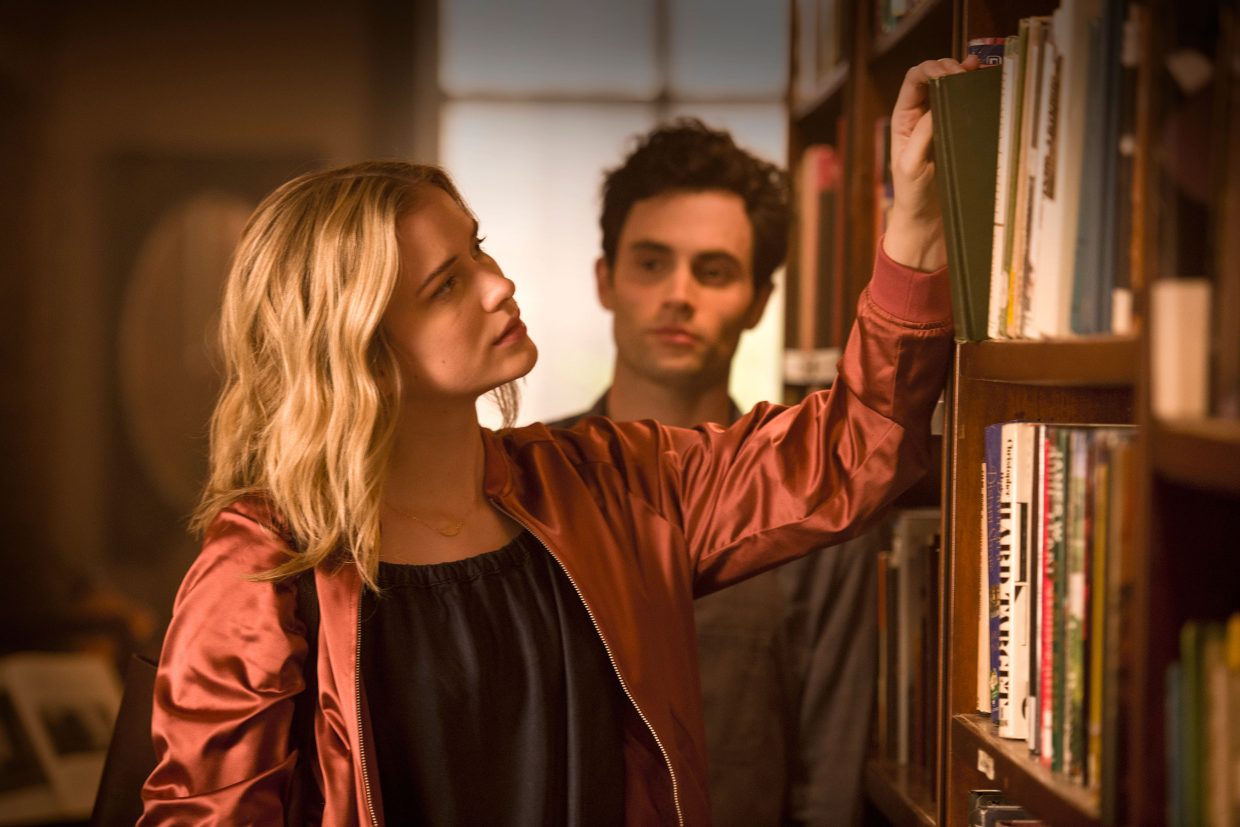
You (Lifetime, 2018-present)
Based on: You by Caroline Kepnes (2014)
You is grim but also cheesy, and it is also just… great. It’s great. It is a variety of television maybe equivalent to a White Castle fast food order: highly addictive, bad for your blood pressure, fun to consume with friends, a little bit trashy but also highbrow (did you guys know that White Castle serves the Impossible Burger now?), and manufactured in Yorkville, a quiet neighborhood in Manhattan due East of the Upper East Side, home mostly to dog-owning elderly people, that bookstore where the show takes place, and the last white concrete hamburger palace left on the island.
Based on the novel by Caroline Kepnes, You is nostalgic for an old-school, local New York, which is clever because of the narrative’s heavy reliance on twenty-first-century digital technology. The show might seem to condemn social media, say, for being the reason why predatory men can find things out about the women over whom they obsess, but all the show’s roadsters, old books, and J.D. Salinger references remind us that what the show is, is old-fashioned. Actually, it’s timeless. Like the many beautiful brownstones and non-over-developed quaint neighborhoods the show likes to take us to, the creepiness and entitlement exhibited by You’s male protagonist have long been grandfathered into our culture.
The protagonist is Joe Goldberg (Penn Badgley), a mild-mannered bookstore manager and antique book restorer who falls for a young writer named Guinevere Beck (Elizabeth Lail). She prefers to be called “Beck,” which is dumb. Except then he stalks her—learning everything about her on the internet, watching her in her apartment, breaking into her apartment, stealing her things, murdering her good-for-nothing rich guy hookup, murdering her suspicious best friend, and eventually manipulating her into falling for him too, becoming her boyfriend while still continuing to stalk her. Mostly, he’s obsessed with taking care of her, and nurturing her talent (she is a mess). Actually, she is pretty poorly-written and I wish she were as good a character as Joe. She’s a very clichéd, lost-but-beautiful basic white girl with lots of privilege and daddy issues who is, we are told all the time, ‘a very good writer.” But she is, ultimately, a victim, and the most important thing about her character is that we know none of this is her fault. When she finds out what Joe is, she blames herself, and this is sad. Joe is responsible for it all. He is the spider and she is the fly. As she will write, in her best piece of writing in the show, he seems to be Prince Charming, but turns out to be Bluebeard. His castle will turn out to be her prison.
Joe is an extremely sinister figure, whose evilness is properly disguised and revealingly compounded by the fact that he thinks he is the protagonist in a romantic comedy, and that he is very handsome and charming. (The show sets a lot of scenes in that charming café from You’ve Got Mail on the Upper West Side, and you’re crazy if you don’t see parallels between Joe, and Annie in Sleepless in Seattle.) You has a few things to say about how many rom-coms (or fairy tales!) are actually creepy. The show is invested in representing how monsters are made of men, and this is sometimes very interesting and productive; other times, the show is fine to just thrill you with its shocking, suspenseful plot points. The intensity of Joe’s obsession (plus all scenes about graduate school) occasionally balloon into absurdity. Sometimes the writing is super sensationalistic. But it is also very serious and worry-inducing. You will worry about Beck. You will hope she gets away from him. You will worry about all women. And you will be scared by the idea that the cute guy you meet on a dating app might be a psychotic murderer. And then you’ll remember that Beck meets Joe in person, in a bookstore, and that the modern trappings of his villainy are purely incidental—a new framework for a very old, eternal danger.
–Olivia Rutigliano, CrimeReads Editorial Fellow
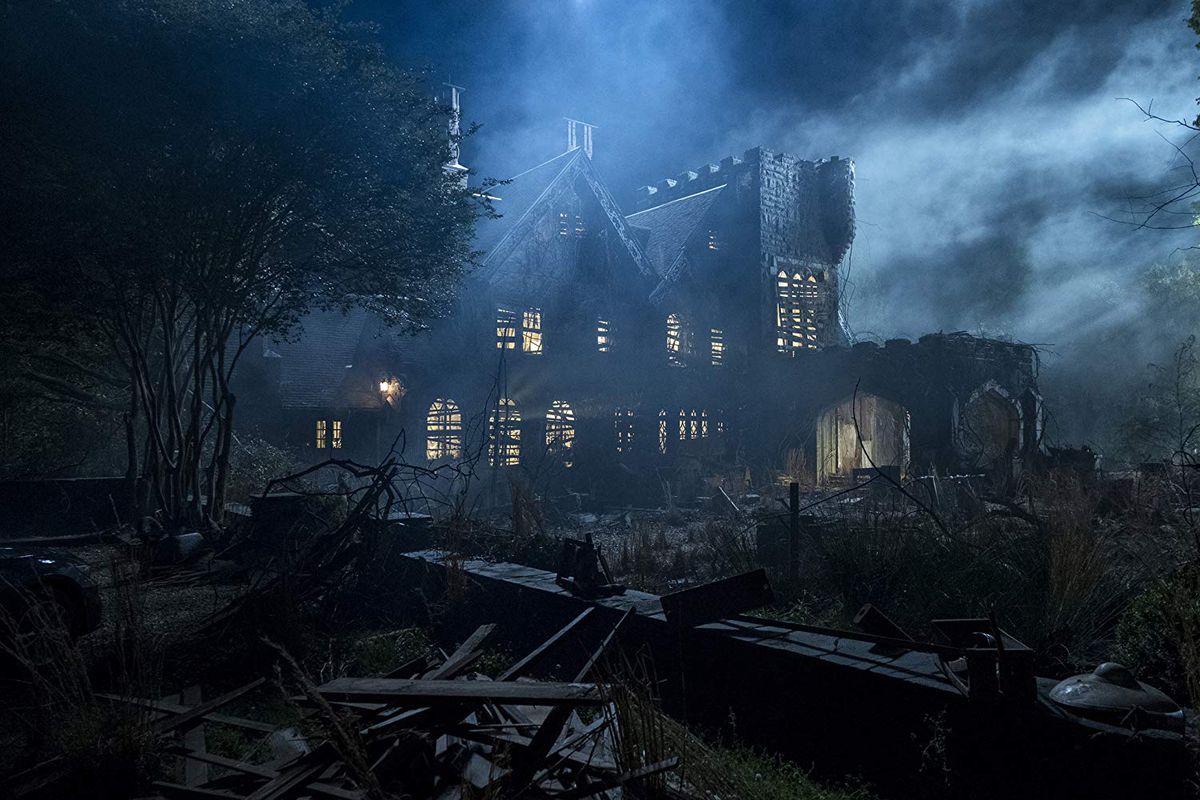
The Haunting of Hill House (Netflix, 2018-present)
Based on: The Haunting of Hill House by Shirley Jackson (1959)
The Haunting of Hill House, the book, profoundly moved me when I read it. (Haunted, actually, would be the term seeing as I couldn’t sleep for two weeks after completing it, but I’m trying to not be too on-the-nose.) Shirley Jackson published The Haunting of Hill House in 1959: Eleanor Vance a shy, anxious 32-year-old woman has just lost her mother, whom she had been nursing for 11 years, and has been invited by a paranormal researcher, along with two other people, to spend the summer at a haunted house. The possibility of escaping her drab life gives Eleanor the chutzpah to steal her sister’s car and, on her drive to the house, dream up an entirely new personality and life for herself. The Haunting of Hill House, the book, is focused entirely on Eleanor, her eccentricities, her anxieties, her relationship to the house which, creepily, gradually, reciprocates her attention in ways she did not anticipate. Jackson pried open the female psyche and criticized the oppressiveness of the household, the prison that could be the home, and in the process also wrote a hell of a ghost story. The Haunting of Hill House, the Netflix original series directed by Mike Flanagan, focuses on a family, the Crains, who live in Hill House until its hauntings become too much to bear.
One disturbing night, the father—having seen his wife increasingly grow ill under the influence of the house (seeing things, hearing things, being possessed: he wakes up one night to find his wife straddling in him in an attempt to kill him)—packs his five kids in the car and flees, leaving his wife to the cursed fate of the house. Flanagan’s show trades the feminist, subtle, horror of Jackson’s novel, for a more overt kind of terror, including jump scares and masked ghosts and women clinging to the ceiling even if he keeps some of Jackson’s original elements. Doors still slam unexpectedly, unexplained drafts plague certain parts of the house, and written on the walls in paint are the words, HELP ELEANOR COME HOME. All the same, the success and lingering impression of the series is its slowly unraveling family drama. A favorite, indelible episode is the most confrontational.
In “Two Storms” the family gathers for the funeral of one of its members and, as they all drink, they become as argumentative as they become sincere. The children ask their father for answers about the past, the house, his choice to abandon their mother, and finally, he tells them. The cinematography of the episode is stunning, placing its characters in the corners of one room of the funeral home, playing with shadows and deep colors and seamless switches between the characters’ perspectives. The narrative arc blends past and present, and their discussion is interspersed with flashbacks from 30 years ago. The episode is heartbreaking and tense and it is representative of the real pain and horror experienced by the family: the loss of their mother and their home and now, their sister and daughter. So, ultimately, coming to the Hill House series may not completely satiate those obsessed with Jackson’s masterpiece, but what Hill House offers is the untangling of fraught family relationships and so, it becomes, a study of vulnerability and connection, through the powerful lens of horror, that shows just how terrifying it can feel to love someone, unconditionally.
–Eleni Theodoropoulos, Editorial Fellow
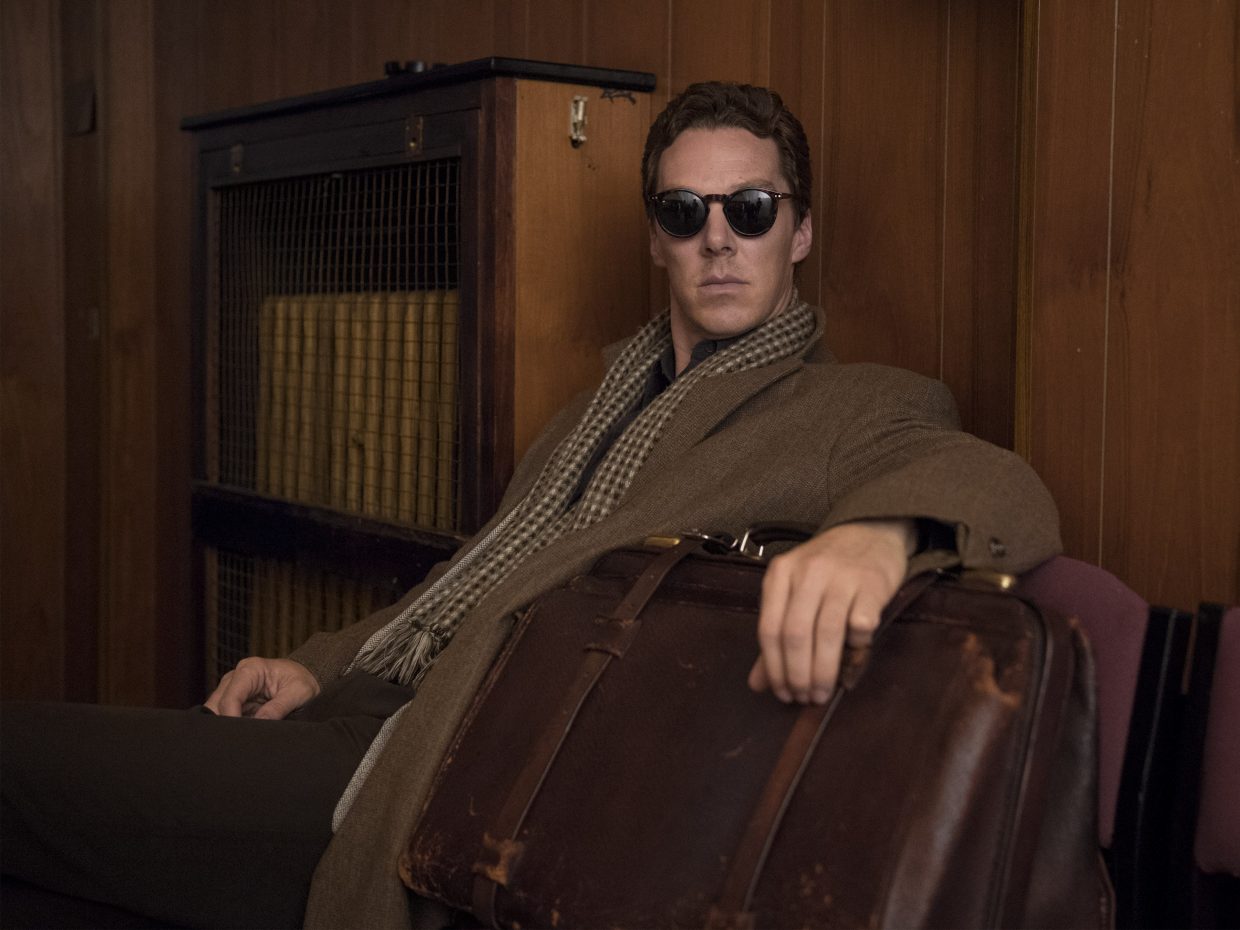
Patrick Melrose (Showtime, 2018)
Based on: The Patrick Melrose novels by Edward St. Aubyn (1992-2012)
This stunning adaptation of Edward St. Aubyn’s semi-autobiographical Patrick Melrose novels is the reason why miniseries should exist. Each episode of the five part series adapts a different book in the five volume cycle, detailing Patrick Melrose’s childhood traumas, youthful self-destruction, and complex journey to healing. The book cycle and miniseries also both function as brutal takedowns of a corrupt aristocracy, rotten to its core, and in need of dismantling.
The first episode of the miniseries follows Patrick on a bender after learning of the death of his father, the second episode introduces us to the horrific abuse the elder Melrose inflicted upon his son (trigger warning for sexual violence), and the third episode takes place during an aristocratic party where Princess Margaret makes a scene and Patrick begins the path to healing. In the 4th episode, we catch up with Patrick as he tries his best to alienate his wife and children, and in the 5th episode, we witness Patrick’s attempt to reconcile with his mother, despite her long history of neglect.
The main difference between books and show is one of story order—the miniseries waits until episode two to drop the bomb about Melrose’s early childhood trauma, while the books are told in chronological order. Benedict Cumberbatch lets his intensity and dark humor out to play Melrose, and while the show as a whole was beautifully (and heart-breakingly) rendered, Cumberbatch’s embodiment of the role deserves a special shoutout.
–Molly Odintz, CrimeReads Associate Editor
***
Honorable Mentions
A selection of other adaptations that we seriously considered for both lists—just to be extra about it (and because decisions are hard).
Mildred Pierce (2011) · Parade’s End (2012) · Longmire (2012-2017) · A Young Doctor’s Notebook (2013) · Olive Kitteridge (2014) · Bosch (2014-present) · Outlander (2014-present) · The Night Manager (2016) · I Love Dick (2016-2017) · Alias Grace (2017) · American Gods (2017-present) · My Brilliant Friend (2018-present) · The Terror (2018-present) · Sharp Objects (2018) · Altered Carbon (2018-present) · Good Omens (2019) · Shrill (2019)

